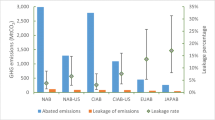Abstract
The aim of this paper is to evaluate two policies Switzerland could follow to curb its CO2 emissions: the imposition of a domestic carbon tax, and the combining of such a tax with the buying of CO2 permits on an international market. These evaluations are done with the general equilibrium model GEM-E3 Switzerland. Besides contributing to the Swiss political debate, the aim of this paper is more generally to illustrate, through an explicit case study, the interest of combining national and international economic instruments to reduce greenhouse gas emissions (CO2, in particular).
Access this chapter
Tax calculation will be finalised at checkout
Purchases are for personal use only
Preview
Unable to display preview. Download preview PDF.
Similar content being viewed by others
References
P.S. Armington, A Theory of Demand for Products Distinguished by Place of Production, International Monetary Fund Staff Papers 16, pp 159–178, 1969.
O. Bahn, and C. Frei, GEM-E3 Switzerland: A Computable General Equilibrium Model Applied for Switzerland, PSI Bericht Nr. 00–01, Paul Scherrer Institute, Villigen, 2000.
O. Bahn, E. Pragniere, and S. Kypreos, Swiss Energy Taxation Options to Curb CO2 Emissions, European Environment 8, pp 107–115, 1998.
P. Capros, et al., The GEM-E3 Model: Reference Manual, National Technical University of Athens, 1997.
J. De Melo, Computable General Equilibrium Models for Trade Policy Analysis in Developing Countries: A Survey, Journal of Policy Modeling 10, pp 469–503, 1988.
S. Guillet and G. Antille, Une Modélisation Multi-sectorielle de l’Economie Suisse, Mémoire préliminaire de thèse, LEA, University of Geneva, 1998.
International Energy Agency, Energy Statistics of OECD Countries 1995–1996, IEA Statistics, Paris, 1998.
International Energy Agency, Energy Balances of OECD Countries 1994–1995, IEA Statistics, Paris, 1997.
International Panel on Climate Change, Climate Change 1995 — The Science of Climate Change, UK, Cambridge: Cambridge University Press, 1996.
International Panel on Climate Change, Climate Change 1995 — Impacts, Adaptations and Mitigation of Climate Change, UK, Cambridge: Cambridge University Press, 1996.
Swiss Agency for the Environment, Forests and Landscape, Manuel: Coefficients d’Emission des Sources Stationnaires, Bern, 1995.
Swiss Customs, Commerce exterieur de la Suisse 1988/97 sur CD-ROM, Bern, 1998.
Swiss Federal Office of Energy, Statistique Globale Suisse de l’Energie 1995, Bern, 1996.
Swiss Federal Office of Energy, Statistique Globale Suisse de l’Energie 1990, Bern, 1991.
Swiss Federal Statistical Office, Annuaire Statistique de la Suisse, Neuchâtel, 2000.
Swiss Federal Statistical Office, Le systeme de comptabilité nationale: Résultats 1992–1997, Neuchatel, 1999.
United Nations, Kyoto Protocol to the United Nations Framework Convention on Climate Change, Conference of the Parties, FCCC/CP/1997/L.7/Add.1, 1997.
United Nations, Framework Convention on Climate Change, International Legal Materials 31, pp 849–873, 1992.
L. Walras, Eléments d’Economie Politique Pure; ou, Théorie de la Richesse Sociale, Lausanne: Corbaz, 1874.
J.P. Weyant, The Costs of the Kyoto Protocol: A Multi-Model Evaluation, Energy Journal, Special Issue, 1999.
Editor information
Editors and Affiliations
Rights and permissions
Copyright information
© 2002 Springer Science+Business Media New York
About this chapter
Cite this chapter
Bahn, O. (2002). Swiss Policy Options To Curb CO2 Emissions: Insights From GEM-E3 Switzerland. In: Zaccour, G. (eds) Decision & Control in Management Science. Advances in Computational Management Science, vol 4. Springer, Boston, MA. https://doi.org/10.1007/978-1-4757-3561-1_7
Download citation
DOI: https://doi.org/10.1007/978-1-4757-3561-1_7
Publisher Name: Springer, Boston, MA
Print ISBN: 978-1-4419-4995-0
Online ISBN: 978-1-4757-3561-1
eBook Packages: Springer Book Archive




